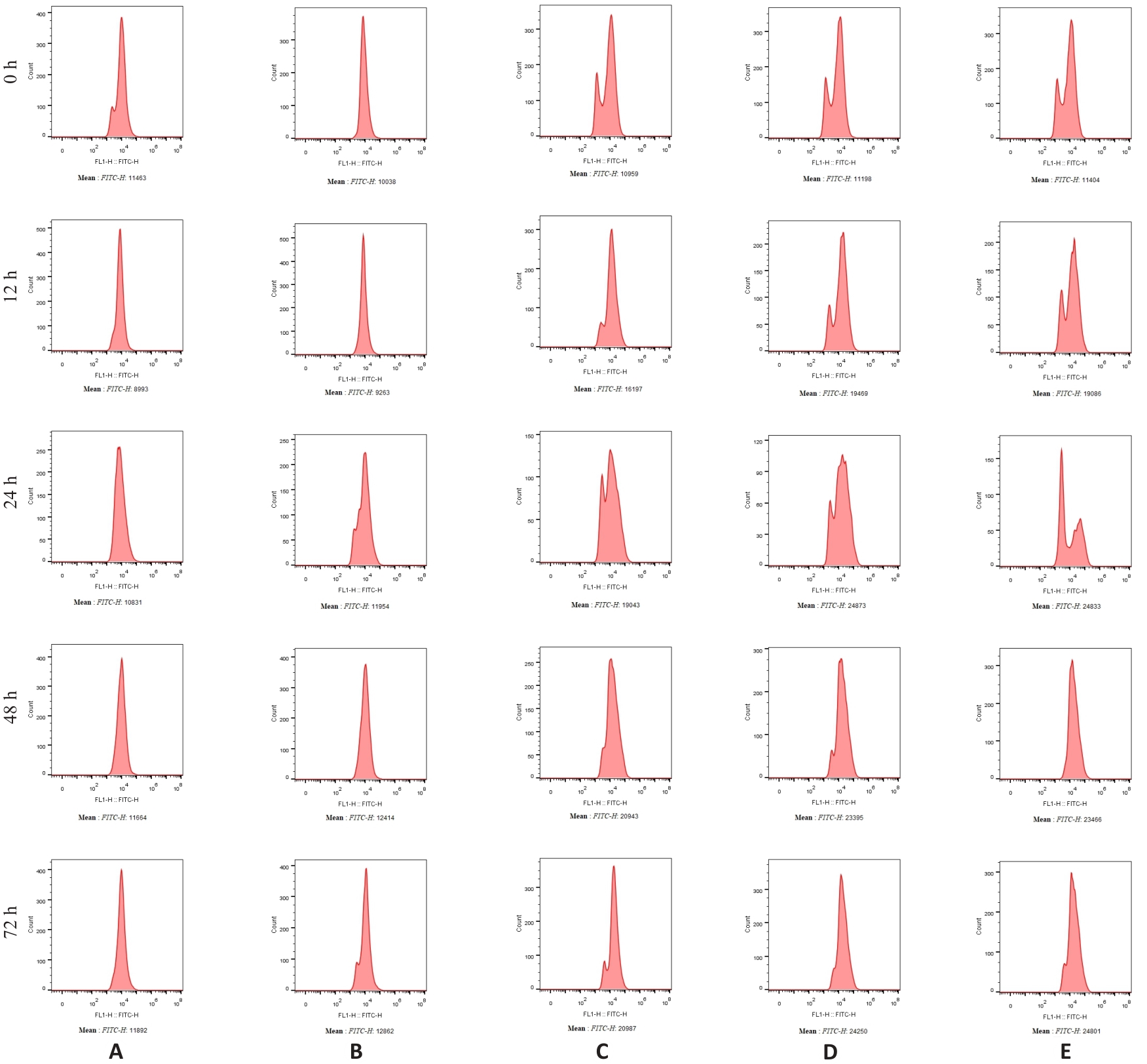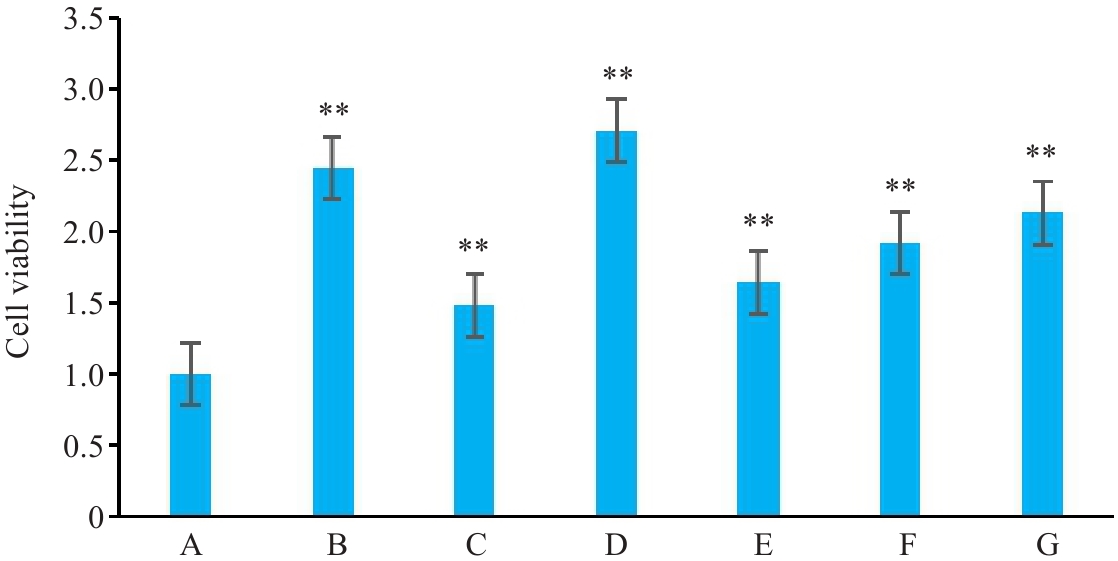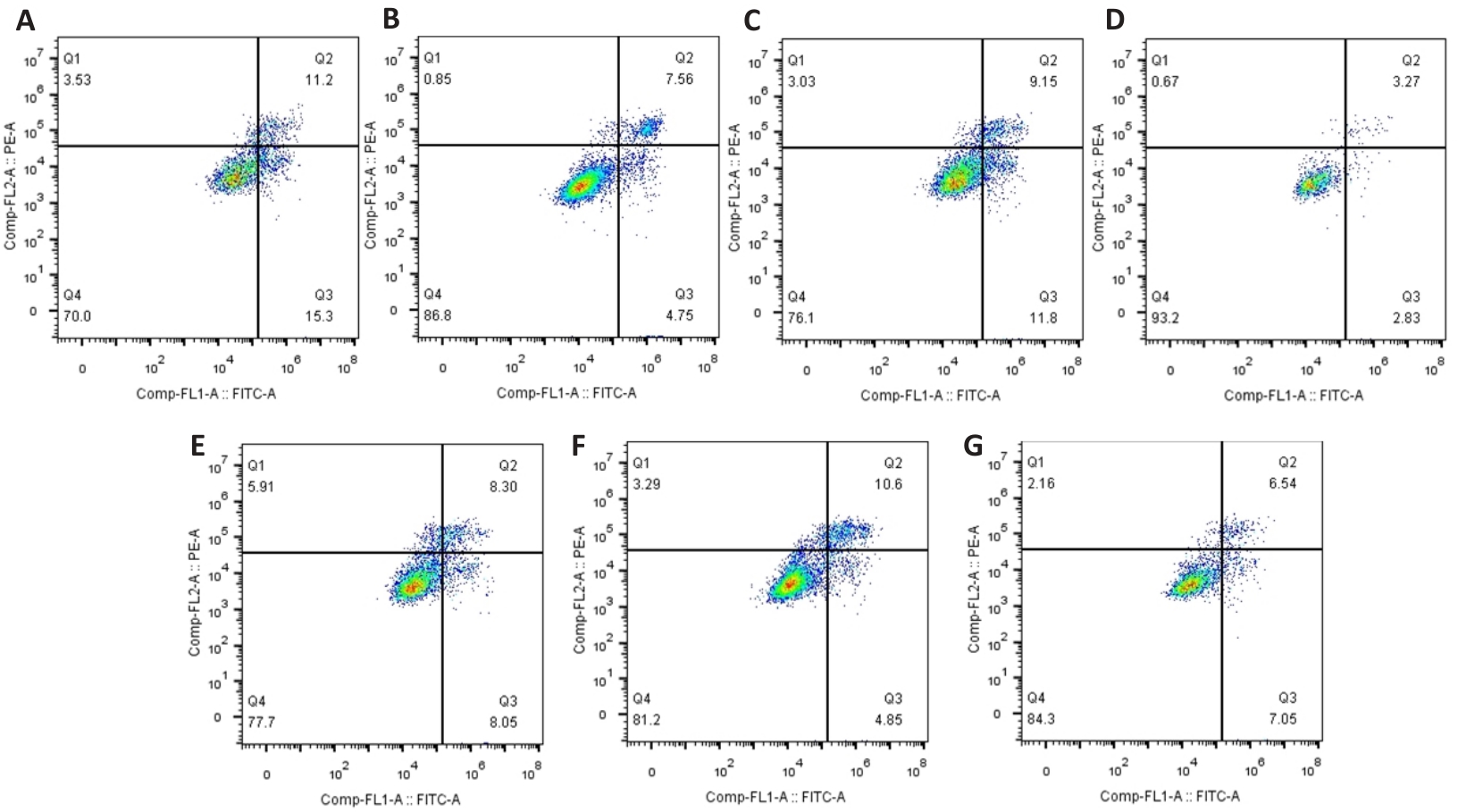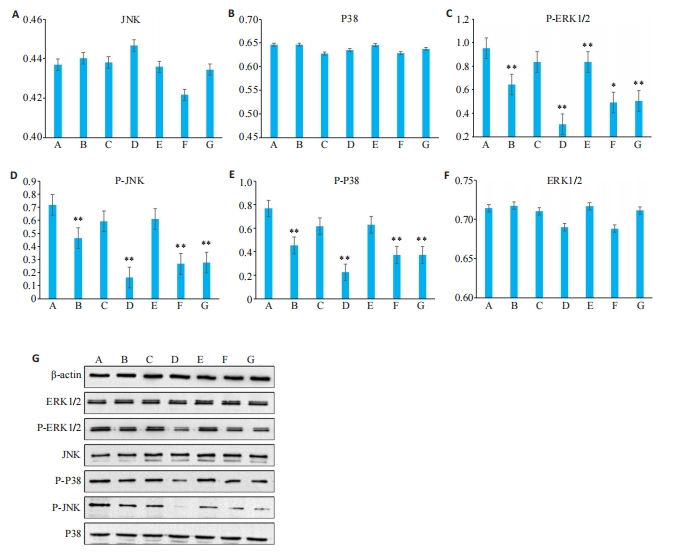Journal of Southern Medical University ›› 2025, Vol. 45 ›› Issue (1): 80-89.doi: 10.12122/j.issn.1673-4254.2025.01.11
Previous Articles Next Articles
Meng XU1( ), Lina CHEN2, Jinyu WU3, Lili LIU4, Mei SHI4, Hao ZHOU4, Guoliang ZHANG4(
), Lina CHEN2, Jinyu WU3, Lili LIU4, Mei SHI4, Hao ZHOU4, Guoliang ZHANG4( )
)
Received:2024-09-06
Online:2025-01-20
Published:2025-01-20
Contact:
Guoliang ZHANG
E-mail:1025473030@qq.com;zhangguoliang61@sina.com
Supported by:Meng XU, Lina CHEN, Jinyu WU, Lili LIU, Mei SHI, Hao ZHOU, Guoliang ZHANG. Mechanism of Hedyotis diffusa-Scutellaria barbata D. Don for treatment of primary liver cancer: analysis with network pharmacology, molecular docking and in vitro validation[J]. Journal of Southern Medical University, 2025, 45(1): 80-89.
Add to citation manager EndNote|Ris|BibTeX
URL: https://www.j-smu.com/EN/10.12122/j.issn.1673-4254.2025.01.11
| Antibody name | Dilution ratio | Species and genus |
|---|---|---|
| JNK | 1:5000 | Mouse |
| p-JNK | 1:1000 | Rabbit |
| P38 | 1:2000 | Rabbit |
| p-P38 | 1:1000 | Mouse |
| ERK1/2 | 1:1000 | Rabbit |
| P-ERK1/2 | 1:1000 | Rabbit |
Tab.1 List of the primary antibodies used for Western blotting
| Antibody name | Dilution ratio | Species and genus |
|---|---|---|
| JNK | 1:5000 | Mouse |
| p-JNK | 1:1000 | Rabbit |
| P38 | 1:2000 | Rabbit |
| p-P38 | 1:1000 | Mouse |
| ERK1/2 | 1:1000 | Rabbit |
| P-ERK1/2 | 1:1000 | Rabbit |
| MOL | MOL name | OB% | DL |
|---|---|---|---|
| MOL000098 | quercetin | 46.43 | 0.28 |
| MOL000358 | beta-sitosterol | 36.91 | 0.75 |
| MOL000449 | Stigmasterol | 43.83 | 0.76 |
Tab.2 Drug shared genes
| MOL | MOL name | OB% | DL |
|---|---|---|---|
| MOL000098 | quercetin | 46.43 | 0.28 |
| MOL000358 | beta-sitosterol | 36.91 | 0.75 |
| MOL000449 | Stigmasterol | 43.83 | 0.76 |
| Active ingredient | Coregene | Bindingenergy (kcal/mol) |
|---|---|---|
| 2-hydroxy-3-methylanthraquinone | TP53 | -4.41 |
| ESR1 | -4.34 | |
| 2-methoxy-3-methyl-9,10-anthraquinone | TP53 | -4.73 |
| ESR1 | -4.01 | |
| Quercetin | TP53 | -3.05 |
| Beta-sitosterol | TP53 | -3.79 |
| ESR1 | -4.18 | |
| Ursolic acid | TP53 | -4.49 |
| ESR1 | -4.98 | |
| Poriferasterol | TP53 | -4.7 |
| ESR1 | -4.52 | |
| Stigmasterol | TP53 | -3.97 |
| ESR1 | -4.7 | |
| Rivularin | TP53 | -3.2 |
| Chrysin-5-methylether | TP53 | -4.26 |
| 7-hydroxy-5,8-dimethoxy-2-phenyl-chromone | TP53 | -3.48 |
| ESR1 | -3.06 | |
| 5-hydroxy-7,8-dimethoxy-2-(4-methoxyphenyl)chromone | TP53 | -3.38 |
| 5,7,4'-trihydroxy-6-methoxyflavanone | TP53 | -3.53 |
| Moslosooflavone | TP53 | -3.18 |
| eriodictyol | TP53 | -3.68 |
| Salvigenin | TP53 | -3.56 |
| ESR1 | -3.18 | |
| Baicalin | TP53 | -3.14 |
| ESR1 | -3.51 | |
| Baicalein | TP53 | -3.69 |
| Sitosteryl acetate | TP53 | -4.71 |
| ESR1 | -4.34 | |
| 24-Ethylcholest-4-en-3-one | TP53 | -4.26 |
| ESR1 | -3.89 | |
| Dinatin | TP53 | -3.39 |
| (2R)-5,7-dihydroxy-2-(4-hydroxyphenyl)chroman-4-one | TP53 | -3.38 |
| ESR1 | -3.21 | |
| CLR | TP53 | -4.45 |
| ESR1 | -4.63 | |
| Sitosterol | TP53 | -3.83 |
| ESR1 | -4.25 | |
| Wogonin | TP53 | -3.61 |
Tab.3 Binding energy of drug active ingredients and final core gene docking (part)
| Active ingredient | Coregene | Bindingenergy (kcal/mol) |
|---|---|---|
| 2-hydroxy-3-methylanthraquinone | TP53 | -4.41 |
| ESR1 | -4.34 | |
| 2-methoxy-3-methyl-9,10-anthraquinone | TP53 | -4.73 |
| ESR1 | -4.01 | |
| Quercetin | TP53 | -3.05 |
| Beta-sitosterol | TP53 | -3.79 |
| ESR1 | -4.18 | |
| Ursolic acid | TP53 | -4.49 |
| ESR1 | -4.98 | |
| Poriferasterol | TP53 | -4.7 |
| ESR1 | -4.52 | |
| Stigmasterol | TP53 | -3.97 |
| ESR1 | -4.7 | |
| Rivularin | TP53 | -3.2 |
| Chrysin-5-methylether | TP53 | -4.26 |
| 7-hydroxy-5,8-dimethoxy-2-phenyl-chromone | TP53 | -3.48 |
| ESR1 | -3.06 | |
| 5-hydroxy-7,8-dimethoxy-2-(4-methoxyphenyl)chromone | TP53 | -3.38 |
| 5,7,4'-trihydroxy-6-methoxyflavanone | TP53 | -3.53 |
| Moslosooflavone | TP53 | -3.18 |
| eriodictyol | TP53 | -3.68 |
| Salvigenin | TP53 | -3.56 |
| ESR1 | -3.18 | |
| Baicalin | TP53 | -3.14 |
| ESR1 | -3.51 | |
| Baicalein | TP53 | -3.69 |
| Sitosteryl acetate | TP53 | -4.71 |
| ESR1 | -4.34 | |
| 24-Ethylcholest-4-en-3-one | TP53 | -4.26 |
| ESR1 | -3.89 | |
| Dinatin | TP53 | -3.39 |
| (2R)-5,7-dihydroxy-2-(4-hydroxyphenyl)chroman-4-one | TP53 | -3.38 |
| ESR1 | -3.21 | |
| CLR | TP53 | -4.45 |
| ESR1 | -4.63 | |
| Sitosterol | TP53 | -3.83 |
| ESR1 | -4.25 | |
| Wogonin | TP53 | -3.61 |

Fig.8 ROS flow cytometry analysis. A: HepG2. B: 0 µmol/L ursolic acid. C: 20 µmol/L ursolic acid. D: 40 µmol/L ursolic acid. E: 80 µmol/L ursolic acid.

Fig.10 Effects of usolic acid and sorafenib on viability of HepG2 cells. A: LO-2. B: HepG2+blank serum. C: HepG2+40 µmol/L ursolic acid. D: HepG2+1.5 µmol/L JNK inhibitor. E: HepG2+sorafenib (10 µmol/L, cultured for 24 hours). F: HepG2+40 µmol/L ursolic acid+1.5 µmol/L JNK inhibitor. G: HepG2+sorafenib (10 µmol/L, cultured for 24 hours)+1.5 µmol/L JNK inhibitor. **P<0.01 vs A.

Fig.11 Apoptosis rate of HepG2 cells with different treatments. A: LO-2. B: HepG2. C: HepG2+optimal concentration of ursolic acid. D: HepG2+optimal concentration of JNK inhibitor. E: HepG2+sorafenib (10 µmol/L, cultured for 24 hours). F: HepG2+optimal concentration of ursolic acid+optimal concentration of JNK inhibitor. G: HepG2+sorafenib (10 µmol/L, cultured for 24 hours)+optimal concentration of JNK inhibitor.

Fig.12 Relative expression levels of proteins in HepG2 cells with different treatments. A: LO-2. B: HepG2. C: HepG2+optimal concentration of ursolic acid. D: HepG2+optimal concentration of JNK inhibitor. E: HepG2+sorafenib (10 µmol/L, cultured for 24 hours). F:HepG2+optimal concentration of ursolic acid+optimal concentration of JNK inhibitor. G: HepG2+sorafenib (10 µmol/L, cultured for 24hours)+optimal concentration of JNK inhibitor *P<0.05, **P<0.01vs A.
| 1 | Parkin DM, Bray F, Ferlay J, et al. Global cancer statistics, 2002[J]. CA Cancer J Clin, 2005, 55(2):74-108. |
| 2 | El-Serag, Hashem B. Hepatocellular Carcinoma[J]. J Clin Gastroenterol, 2002,35(5):72-8. |
| 3 | Ananthakrishnan A, Gogineni V, Saeian K. Epidemiology of primary and secondary liver cancers[J]. Semin Intervent Radiol, 2006, 23(1): 47-63. |
| 4 | Donato F, Boffetta P, Puoti M. A meta-analysis of epidemiological studies on the combined effect of hepatitis B and C virus infections in causing hepatocellular carcinoma[J]. Int J Cancer, 1998, 75(3): 347-54. |
| 5 | Kew MC, dos Santos HA, Sherlock S. Diagnosis of primary cancer of the liver[J]. Br Med J, 1971, 4(5784): 408-11. |
| 6 | Li ZQ. Traditional Chinese medicine for primary liver cancer[J]. World J Gastroenterol, 1998, 4(4): 360. |
| 7 | Hu CJ, He J, Li GZ, et al. Analyzing hedyotis diffusa mechanisms of action from the genomics perspective[J]. Comput Meth Programs Biomed, 2019, 174: 1-8. |
| 8 | Qian K, Fu D, Jiang BR, et al. Mechanism of Hedyotis diffusa in the treatment of cervical cancer[J]. Front Pharmacol, 2021, 12: 808144. |
| 9 | Wang TS, Wang SQ, Xiao DL. A review of phytochemistry and antitumor activity of a valuable medicinal species: Scutellaria barbata[J]. J Med Plant Res, 2012,6(26):4259-75. |
| 10 | 杨培伟, 朱金霞, 陈欣菊, 等.半枝莲-白花蛇舌草调控Wnt/β-catenin轴对肝癌迁移和侵袭的作用机制研究[J/OL].中药药理与临床,2024,11:1-18. |
| 11 | Xu TF, Li SZ, Sun YF, et al. Systematically characterize the absorbed effective substances of Wutou Decoction and their metabolic pathways in rat plasma using UHPLC-Q-TOF-MS combined with a target network pharmacological analysis[J]. J Pharm Biomed Anal, 2017, 141: 95-107. |
| 12 | Ru JL, Li P, Wang JN, et al. TCMSP: a database of systems pharmacology for drug discovery from herbal medicines[J]. J Cheminform, 2014, 6: 13. |
| 13 | Wang JH, Zhao LF, Lin P, et al. GenCLiP 2.0: a web server for functional clustering of genes and construction of molecular networks based on free terms[J]. Bioinformatics, 2014, 30(17): 2534-6. |
| 14 | Shannon P, Markiel A, Ozier O, et al. Cytoscape: a software environment for integrated models of biomolecular interaction networks[J]. Genome Res, 2003, 13(11): 2498-504. |
| 15 | Safran M, Dalah I, Alexander J, et al. GeneCards Version 3: the human gene integrator[J]. Database, 2010, 2010: baq020. |
| 16 | Luo WJ, Brouwer C. Pathview: an R/Bioconductor package for pathway-based data integration and visualization[J]. Bioinformatics, 2013, 29(14): 1830-1. |
| 17 | Martucci D, Masseroli M, Pinciroli F. Gene ontology application to genomic functional annotation, statistical analysis and knowledge mining[J]. Stud Health Technol Inform, 2004, 102: 108-31. |
| 18 | 王 宇, 范璐璐. BET蛋白抑制剂JQ1增强索拉非尼对肝癌细胞的增殖抑制研究[J]. 安徽医科大学学报, 2020, 55(8): 1185-8. |
| 19 | Bykov VJN, Eriksson SE, Bianchi, et al. Targeting mutant p53 for efficient cancer therapy[J]. Nat Rev Cancer, 2018, 18(2): 89-102. |
| 20 | Zhang YY, Cheng JX, Zhong C, et al. ESR1 regulates the obesity- and metabolism-differential gene MMAA to inhibit the occurrence and development of hepatocellular carcinoma[J]. Front Oncol, 2022, 12: 899969. |
| 21 | Elsherbiny NM, Eisa NH, El-Sherbiny M, et al. Chemo-preventive effect of crocin against experimentally-induced hepatocarcinogenesis via regulation of apoptotic and Nrf2 signaling pathways[J]. Environ Toxicol Pharmacol, 2020, 80: 103494. |
| 22 | Xiao SF, Tang HR, Bai Y, et al. Swertiamarin suppresses proliferation, migration, and invasion of hepatocellular carcinoma cells via negative regulation of FRAT1[J]. Eur J Histochem, 2020, 64(4): 3169. |
| 23 | Ripa I, Andreu S, López-Guerrero JA, et al. Membrane rafts: portals for viral entry[J]. Front Microbiol, 2021, 12: 631274. |
| 24 | Brábek J, Hanks SK. Assaying protein kinase activity. In: Dickson, R.C., Mendenhall, M.D. (eds) signal transduction protocols[J]. Methods Molecul Biol, 2020,284: 1302-9. |
| 25 | Roques M, Tirard A, DeGroot LJ. Liver protein kinase activity and triiodothyronine[J]. Endocrinology, 1977, 100(4): 967-73. |
| 26 | Arbuthnot P, Kew M. Hepatitis B virus and hepatocellular carcinoma[J]. Int J Exp Pathol, 2001, 82(2): 77-100. |
| 27 | Martini M, De Santis MC, Braccini L, et al. PI3K/AKT signaling pathway and cancer: an updated review[J]. Ann Med, 2014, 46(6): 372-83. |
| 28 | Baghy K, Tátrai P, Regős E, et al. Proteoglycans in liver cancer[J]. World J Gastroenterol, 2016, 22(1):379-93. |
| 29 | Guicciardi ME, Gores GJ. Apoptosis: a mechanism of acute and chronic liver injury[J]. Gut, 2005, 54(7): 1024-33. |
| [1] | Xinyuan CHEN, Chengting WU, Ruidi LI, Xueqin PAN, Yaodan ZHANG, Junyu TAO, Caizhi LIN. Shuangshu Decoction inhibits growth of gastric cancer cell xenografts by promoting cell ferroptosis via the P53/SLC7A11/GPX4 axis [J]. Journal of Southern Medical University, 2025, 45(7): 1363-1371. |
| [2] | Liming WANG, Hongrui CHEN, Yan DU, Peng ZHAO, Yujie WANG, Yange TIAN, Xinguang LIU, Jiansheng LI. Yiqi Zishen Formula ameliorates inflammation in mice with chronic obstructive pulmonary disease by inhibiting the PI3K/Akt/NF-κB signaling pathway [J]. Journal of Southern Medical University, 2025, 45(7): 1409-1422. |
| [3] | Yinfu ZHU, Yiran LI, Yi WANG, Yinger HUANG, Kunxiang GONG, Wenbo HAO, Lingling SUN. Therapeutic mechanism of hederagenin, an active component in Guizhi Fuling Pellets, against cervical cancer in nude mice [J]. Journal of Southern Medical University, 2025, 45(7): 1423-1433. |
| [4] | Lijun HE, Xiaofei CHEN, Chenxin YAN, Lin SHI. Inhibitory effect of Fuzheng Huaji Decoction against non-small cell lung cancer cells in vitro and the possible molecular mechanism [J]. Journal of Southern Medical University, 2025, 45(6): 1143-1152. |
| [5] | Guoyong LI, Renling LI, Yiting LIU, Hongxia KE, Jing LI, Xinhua WANG. Therapeutic mechanism of Arctium lappa extract for post-viral pneumonia pulmonary fibrosis: a metabolomics, network pharmacology analysis and experimental verification [J]. Journal of Southern Medical University, 2025, 45(6): 1185-1199. |
| [6] | Liping GUAN, Yan YAN, Xinyi LU, Zhifeng LI, Hui GAO, Dong CAO, Chenxi HOU, Jingyu ZENG, Xinyi LI, Yang ZHAO, Junjie WANG, Huilong FANG. Compound Centella asiatica formula alleviates Schistosoma japonicum-induced liver fibrosis in mice by inhibiting the inflammation-fibrosis cascade via regulating the TLR4/MyD88 pathway [J]. Journal of Southern Medical University, 2025, 45(6): 1307-1316. |
| [7] | Peipei TANG, Yong TAN, Yanyun YIN, Xiaowei NIE, Jingyu HUANG, Wenting ZUO, Yuling LI. Tiaozhou Ziyin recipe for treatment of premature ovarian insufficiency: efficacy, safety and mechanism [J]. Journal of Southern Medical University, 2025, 45(5): 929-941. |
| [8] | Xiaotao LIANG, Yifan XIONG, Xueqi LIU, Xiaoshan LIANG, Xiaoyu ZHU, Wei XIE. Huoxue Shufeng Granule alleviates central sensitization in chronic migraine mice via TLR4/NF-κB inflammatory pathway [J]. Journal of Southern Medical University, 2025, 45(5): 986-994. |
| [9] | Niandong RAN, Jie LIU, Jian XU, Yongping ZHANG, Jiangtao GUO. n-butanol fraction of ethanol extract of Periploca forrestii Schltr.: its active components, targets and pathways for treating Alcheimer's disease in rats [J]. Journal of Southern Medical University, 2025, 45(4): 785-798. |
| [10] | Haonan¹ XU, Fang³ ZHANG, Yuying² HUANG, Qisheng⁴ YAO, Yueqin⁴ GUAN, Hao CHEN. Thesium chinense Turcz. alleviates antibiotic-associated diarrhea in mice by modulating gut microbiota structure and regulating the EGFR/PI3K/Akt signaling pathway [J]. Journal of Southern Medical University, 2025, 45(2): 285-295. |
| [11] | Junjie GAO, Kai YE, Jing WU. Quercetin inhibits proliferation and migration of clear cell renal cell carcinoma cells by regulating TP53 gene [J]. Journal of Southern Medical University, 2025, 45(2): 313-321. |
| [12] | Ying LIU, Borui LI, Yongcai LI, Lubo CHANG, Jiao WANG, Lin YANG, Yonggang YAN, Kai QV, Jiping LIU, Gang ZHANG, Xia SHEN. Jiawei Xiaoyao Pills improves depression-like behavior in rats by regulating neurotransmitters, inhibiting inflammation and oxidation and modulating intestinal flora [J]. Journal of Southern Medical University, 2025, 45(2): 347-358. |
| [13] | Qiao CHU, Xiaona WANG, Jiaying XU, Huilin PENG, Yulin ZHAO, Jing ZHANG, Guoyu LU, Kai WANG. Pulsatilla saponin D inhibits invasion and metastasis of triple-negative breast cancer cells through multiple targets and pathways [J]. Journal of Southern Medical University, 2025, 45(1): 150-161. |
| [14] | Xiupeng LONG, Shun TAO, Shen YANG, Suyun LI, Libing RAO, Li LI, Zhe ZHANG. Quercetin improves heart failure by inhibiting cardiomyocyte apoptosis via suppressing the MAPK signaling pathway [J]. Journal of Southern Medical University, 2025, 45(1): 187-196. |
| [15] | Qing LIU, Jing LIU, Yihang ZHENG, Jin LEI, Jianhua HUANG, Siyu LIU, Fang LIU, Qunlong PENG, Yuanfang ZHANG, Junjie WANG, Yujuan LI. Quercetin mediates the therapeutic effect of Centella asiatica on psoriasis by regulating STAT3 phosphorylation to inhibit the IL-23/IL-17A axis [J]. Journal of Southern Medical University, 2025, 45(1): 90-99. |
| Viewed | ||||||
|
Full text |
|
|||||
|
Abstract |
|
|||||